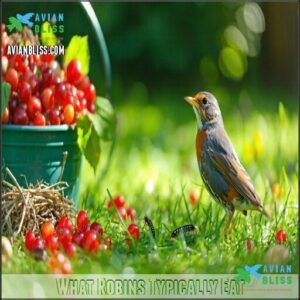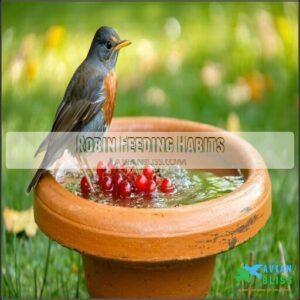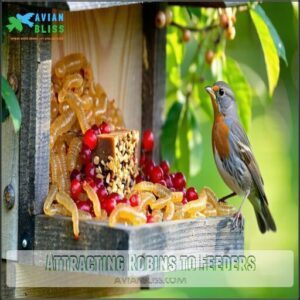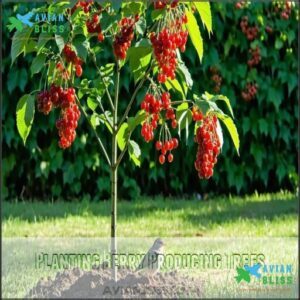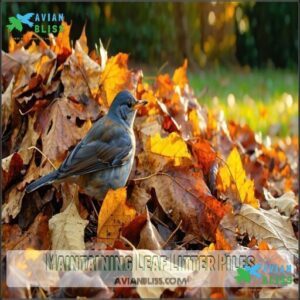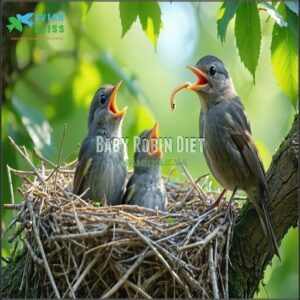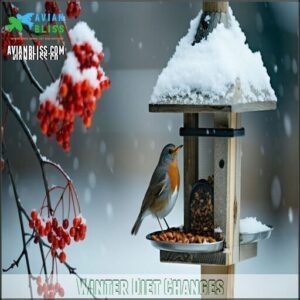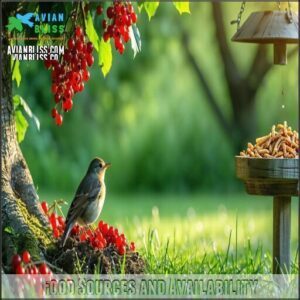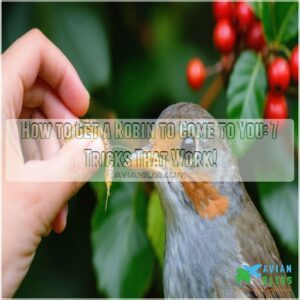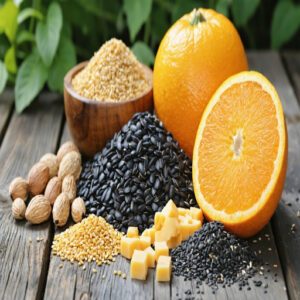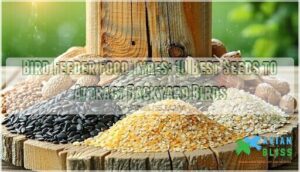This site is supported by our readers. We may earn a commission, at no cost to you, if you purchase through links.
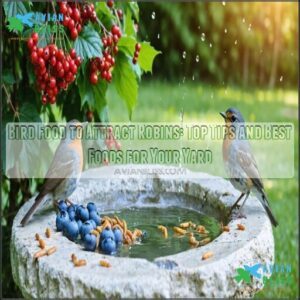 If you’re looking to attract robins, start with their favorite snacks: mealworms, suet, and fruits like blueberries or raisins.
If you’re looking to attract robins, start with their favorite snacks: mealworms, suet, and fruits like blueberries or raisins.
Robins are ground foragers, so spread food on an open tray feeder or directly on the ground for the best results.
Adding berry-producing plants, such as holly or dogwood, can create a natural buffet they won’t resist.
Don’t forget a water source—robins love a fresh bird bath for drinking and bathing, especially in winter when options are scarce.
Avoid using pesticides, as they rely on insects too, and with the right setup, your yard could quickly become a robin hotspot and provide them with their favorite fresh bird bath.
Table Of Contents
Key Takeaways
- Offer mealworms, suet, and a variety of fruits like blueberries or raisins to attract robins.
- Set up an open tray feeder or scatter food on the ground where robins prefer to forage.
- Plant berry-producing shrubs like holly or dogwood to provide natural food sources year-round.
- Add a clean, fresh water source, like a bird bath, and avoid using pesticides to create a safe environment.
What Robins Typically Eat
Robins are omnivorous birds that thrive on a mix of protein-rich insects, earthworms, and snails, along with energy-packed fruits and berries.
Robins flourish on insects, earthworms, and berries, masterfully adapting their diet through seasons to stay energized year-round.
Their diet shifts with the seasons, ensuring they get the nutrients they need year-round, which is a key factor in their survival, and this adaptation allows them to thrive.
Earthworms and Insects
Attracting robins starts with understanding their love for worms and bugs. Earthworms, beetles, and caterpillars are top choices.
Robins use sharp hearing and sight to find prey in soil. Their diet is all about protein-packed insects.
Robins rely on keen hearing and sharp vision to hunt soil-dwelling insects, making protein-packed meals essential to their survival.
- Food Favorites: Earthworms, beetles, and caterpillars.
- Feeding Behavior: Hunt on lawns after rain.
- Robin Attractants: Live worms, insects, and grubs.
Fruits and Berries
Robins love fruits and berries, especially during cooler months.
Berry varieties like blueberries, cherries, and holly berries are a favorite food. Place fruit near shrubs or on open trays for easy access.
Avoid toxic berries like ivy or mistletoe. Winter berries like juniper keep robins well-fed when insects are scarce.
A balanced diet should include items other than bread, as it can lead to angel wing deformity.
| Berry Type | Season | Benefits | Placement |
|---|---|---|---|
| Blueberries | Summer | High nutrients, energy | On tray or bushes |
| Holly Berries | Winter | Excellent winter food | Berry bushes |
| Cherries | Summer | Sweet and juicy | Near shrubs |
| Juniper Berries | Winter | Sustains in cold months | Robin berry bushes |
Mealworms and Suet
If fruits and berries keep robins energized in winter, mealworms and suet are like protein-packed deli treats they can’t resist.
Mealworm nutrition offers essential energy, especially during breeding.
Suet recipes with nuts or dried fruits are a win.
Feed sparingly to avoid waste—small amounts daily work best.
Store suet in cool places, and mealworms dry to preserve freshness and cost efficiency.
Robin Feeding Habits
Robins are ground feeders that rely on sight and sound to locate worms, insects, and other small prey.
Their feeding habits shift with the seasons, focusing on protein-rich invertebrates in warmer months and fruits or berries in winter, which makes them ground feeders.
Hunting Techniques
With keen visual acuity and sharp auditory cues, robins often tilt their heads to locate worms or grubs beneath the soil.
Their foraging behavior is fascinating, watching them dart and hop as they respond to subtle movements or sounds.
Seasonal variation doesn’t hinder their skill at finding insects, proving they’re master hunters regardless of what robins eat during the year, showcasing their ability to adapt and thrive in various conditions, making them successful in their year-round pursuit of food.
Seasonal Diet Changes
Throughout the year, robins adapt their diets to what’s available.
In summer, they enjoy a hearty worm feast. During autumn, fruit abundance like wild berries becomes a key diet component. Winter brings a shift to a berry focus, as insects vanish. Spring sees an insect surge with worms and grubs.
- Summer: Worms dominate.
- Autumn: Fruits, especially berries, take over.
- Winter: Berries remain essential.
Water Sources
A reliable water source is key for attracting robins to your backyard.
Place bird baths near shrubs for safety and easy access. Heated bird baths keep water available in winter, a lifesaver when ponds freeze.
Clean water sources regularly to prevent disease.
Natural water features, like shallow fountains or streams, mimic their habitat and make your yard truly robin-friendly. A balanced diet, rather than just feeding bread, is essential for their health.
Attracting Robins to Feeders
To attract robins to feeders, focus on offering foods they can’t resist, like mealworms, fruits, and suet.
Place open tray feeders near shrubs or berry-producing trees to create a welcoming, natural feeding spot.
Open Tray Feeders
Open tray feeders make feeding robins a breeze! Their simple design attracts these curious birds with easy access to food like raisins, apple slices, and mealworms.
Robins are also known for their bold ground-feeding behaviors.
To keep robins happy, consider the following tips:
- Place trays near shrubs for safety.
- Add robin favorite food like fruit.
- Provide weather protection with a covered feeder.
- Clean regularly for maintenance.
- Choose sturdy, accessible designs.
Suitable Foods
Robins thrive on worms, fruit, and mealworms. They’ll skip birdseed, but offering mealworms for robins and soft fruits like berries works wonders.
You can find robin-specific mealworms online.
Avoid toxic foods like salty snacks or chocolate. Organic options, like pesticide-free berries, are safer.
Present robin favorite food on open trays or scatter it on the ground. Keep food storage clean to guarantee freshness.
Feeder Placement
Place bird feeders at a mid-height level, offering visibility while shielding them from predators.
Choose sunny spots to highlight robin food sources, but make certain some weather protection, like nearby shrubs or trees.
Robins prefer open tray feeders with mealworms or suet. Consider optimal feeder locations for attracting more robins.
Strategic feeder placement boosts your chances of attracting robins to your backyard for safe, accessible feeding.
Top 3 Bird Foods for Robins
If you want to attract robins to your yard, offering the right foods is essential. Mealworms, fruits, and suet provide the perfect mix of nutrients and energy they need.
1. Kaytee Wild Bird Food Mealworms
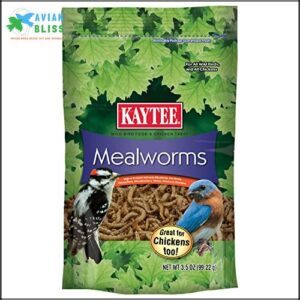
When choosing food for robins, Kaytee Wild Bird Food Mealworms stands out.
Packed with protein, it’s perfect for fueling robins, especially during breeding season or harsh winters.
Mealworms are an irresistible treat, mimicking their natural diet of insects.
These oven-dried mealworms guarantee quality and can be fed alone or mixed with seeds.
Offering them in an open tray feeder near shrubs or berry bushes increases your chances of attracting robins.
It’s a fantastic way to support their energy and nourishment needs, providing them with quality food.
Best For: Wildlife enthusiasts looking to attract and nourish robins and other insect-loving birds.
- High-protein, high-energy treat for birds.
- Oven-dried for quality and long shelf life.
- Versatile use as a standalone feed or mixed with seeds.
- Requires proper storage to prevent spoilage.
- May attract unwanted pests if left unattended.
- Needs an appropriate feeder for mealworms.
2. Pennington Select Mealworms Wild Bird Food
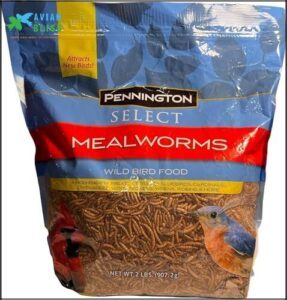
Pennington Select Mealworms Wild Bird Food is a game-changer if you’re looking to attract robins.
Packed with 100% dried mealworms, it’s high in protein and energy—perfect for robins year-round.
Its versatile blend appeals to both insect and seed-eating birds, making it a favorite for bluebirds, chickadees, and more.
Enhanced with essential vitamins and minerals, it’s nutritious and easy to use in shallow dishes or specialized feeders.
Plus, its resealable bag keeps freshness intact, giving you more chances to welcome robins to your yard.
Best For: Bird enthusiasts looking to attract a variety of wild birds, especially robins, with a high-protein, nutrient-rich treat.
- High in protein and energy, perfect for wild birds year-round.
- Attracts both insect and seed-eating birds, increasing bird variety in your yard.
- Resealable bag ensures freshness and easy storage.
- Limited to dried mealworms, which might not appeal to all bird species.
- Requires proper feeder setup for optimal use.
- Can spoil if not stored in a cool, dry place.
3. Large Stainless Steel Bird Feeder Tray
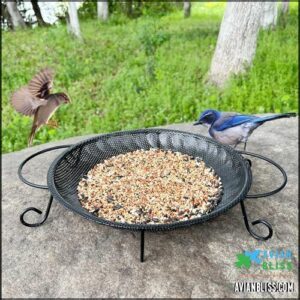
The Large Stainless Steel Bird Feeder Tray is perfect for attracting robins.
Its open, perforated design keeps food dry and fresh, ensuring mealworms, fruits, and suet stay appetizing.
With space for 2-3 lbs of food, it’s sturdy, rust-proof, and easy to clean.
Place it near berry-producing trees or shrubs to encourage robins to visit.
Its wide tray suits robins’ natural feeding style, offering an ideal space for them to forage comfortably, and helps create a welcoming, robin-friendly yard.
Best For: Nature enthusiasts, families, and bird lovers looking to attract robins and other birds to their yard.
- Open perforated design keeps food dry and fresh.
- Large capacity and rust-proof, durable materials.
- Easy to clean and suitable for a variety of bird foods.
- Not specifically designed to deter squirrels.
- Requires placement near specific plants or shrubs for optimal results.
- May need frequent refilling in areas with high bird activity.
Creating Robin Friendly Yards
You can create a robin-friendly yard by planting berry-producing trees, leaving leaf litter for insects, and adding a heated bird bath for winter months.
These steps provide robins with essential food, shelter, and water, helping them thrive year-round, which is crucial for their survival and can be considered as providing them shelter.
Planting Berry Producing Trees
Incorporating berry-producing trees like chokecherry and hawthorn into your yard boosts robin food sources while attracting robins to your garden.
When planning, consider Berry Tree Selection, Soil Preparation, and Tree Placement for maximum growth.
Provide consistent Watering Needs and practice Pruning Techniques to guarantee healthy fruit production.
With this approach, you’ll create a habitat inviting robins year-round.
Maintaining Leaf Litter Piles
Leaf litter piles are a goldmine for robins, offering insect habitats and worms they love.
As the leaves decompose, they enrich the soil, acting as natural mulch.
During winter, leaf litter provides shelter for insects, ensuring a year-round robin food source.
By encouraging decomposition benefits in your yard, you’ll be attracting robins to your backyard effortlessly with natural mulch.
Providing Heated Bird Baths
After setting up leaf litter piles, consider a heated bird bath as a reliable robin water source.
It offers Winter Water to drink and bathe, supporting their winter diet.
Placement Matters—keep it accessible yet safe. Bath Temperature stays ideal with low Energy Consumption.
Consider browsing options for a suitable heated option for your yard.
Follow simple Maintenance Tips like cleaning regularly to guarantee a robin friendly yard, attracting robins backyard consistently.
Robin Diet Variations
Robins adjust their diet based on the season and food availability, eating more insects and worms in warmer months and switching to fruits and berries in winter.
Understanding these variations helps you provide the right foods to attract them year-round, which is crucial for attract them effectively.
Baby Robin Diet
Baby robins start life eating regurgitated food from parents, packed with nutrients.
By day five, their diet expands to include worms, insects, and grubs, broken into small bites.
Fruits like berries are added later.
Frequent feeding, every 15-20 minutes, is essential.
If you’re caring for one, provide baby bird food, mealworms, and live food for robins to guarantee proper growth.
Winter Diet Changes
Winter changes the game for robins.
With insect scarcity and berry availability shrinking, they switch to alternative foods like suet and fruit. Migration patterns push them to seek energy-rich options.
Feeding robins in winter is easier with suet consumption or scattering mealworms.
Bird feeding tips? Keep offerings fresh and accessible—they’ll thank you with songs come spring.
Food Sources and Availability
When robins seek food sources, their diet reflects seasonal abundance and adaptability.
They thrive in backyards, balancing natural foraging with urban food options.
Nutrient-rich favorites include:
- Worms and insects for protein.
- Soft fruit like berries for energy boosts.
- Alternative foods like suet in colder months.
- Mealworms for ease at feeders.
- Adjustments as food competition shifts daily.
Designing Robin Friendly Spaces
To create spaces that robins love, focus on providing natural food sources and safe foraging areas.
Incorporate native plants, reduce pesticide use, and maintain open ground for easy access to insects and berries, which are natural food sources.
Ground Foraging Environment
Creating a ground foraging environment is key to attracting robins.
Keep open spaces clear of dense vegetation, and maintain natural groundcover like leaf litter to nurture insects, their favorite snacks.
Avoid harsh pesticides and instead use safe options to protect robin habitat attractants.
Pair this with water access to encourage foraging, enhancing your garden’s natural food sources.
Native Plant Incorporation
Incorporating native plants into your yard benefits both local ecosystems and robin habitat attractants.
Native berries like dogwood or serviceberry provide essential nutrition, complementing robin diet preferences year-round.
These plants also create insect habitats and natural shelters for foraging and nesting, which supports biodiversity.
By focusing on habitat restoration through native plants, you’ll establish a bird-friendly garden that delights robins and supports biodiversity.
Minimizing Pesticide Use
Swap pesticides for organic solutions to keep your garden ecosystem thriving and safe for robins.
Promote natural predators like ladybugs or birds to manage pests. Plant native species—they’re resilient and need fewer chemicals.
Organic gardening fosters a pesticide-free, bird-friendly yard. A healthier ecosystem means robins can forage safely, adding life and song to your garden’s serene atmosphere.
Protecting birds that provide natural pest control further reduces the need for pesticides, creating a more natural environment.
Frequently Asked Questions (FAQs)
Can robins eat peanut butter safely?
If peanut butter is like nature’s glue, robins can enjoy it in moderation.
Make sure it’s unsweetened, salt-free, and spread thinly on fruits or suet.
Too much can overwhelm their tiny systems, so moderation is key to ensuring the robins’ health.
How do robins find food during winter?
Robins rely on berries, fruits, and suet during winter when worms and insects are scarce.
They forage in shrubs, trees, and on the ground, using sharp vision to spot bright fruits or hidden food sources.
What are the risks of feeding robins bread?
Feeding robins bread isn’t ideal—it lacks nutrients they need and can fill them up, stopping them from eating healthier food.
Bread molds quickly too, which can harm robins if consumed.
Stick to fruits or mealworms.
Do robins prefer fresh or dried fruits?
Imagine a colorful buffet—robins love variety.
Fresh fruits like apple slices or berries are ideal, offering hydration and nutrients.
Dried fruits work too, especially raisins or cherries, but soak them first for easier eating.
How can I keep robins safe from predators?
To keep robins safe, limit pesticide use, keep cats indoors, and provide dense shrubs or trees for shelter.
Avoid leaving food in open spaces where predators lurk.
Create a secure, robin-friendly environment with thoughtful planning.
Conclusion
Transforming your yard into a robin-friendly refuge is simpler than it seems.
By offering their preferred bird food to attract robins, such as mealworms, suet, and fruits, you provide the sustenance they crave.
Make certain access to clean water and plant native berry-producing shrubs like holly or dogwood to create a natural feast.
Avoid pesticides, as robins rely on insects as well, and with the right setup, your yard can become a seasonal sanctuary for these delightful birds.

